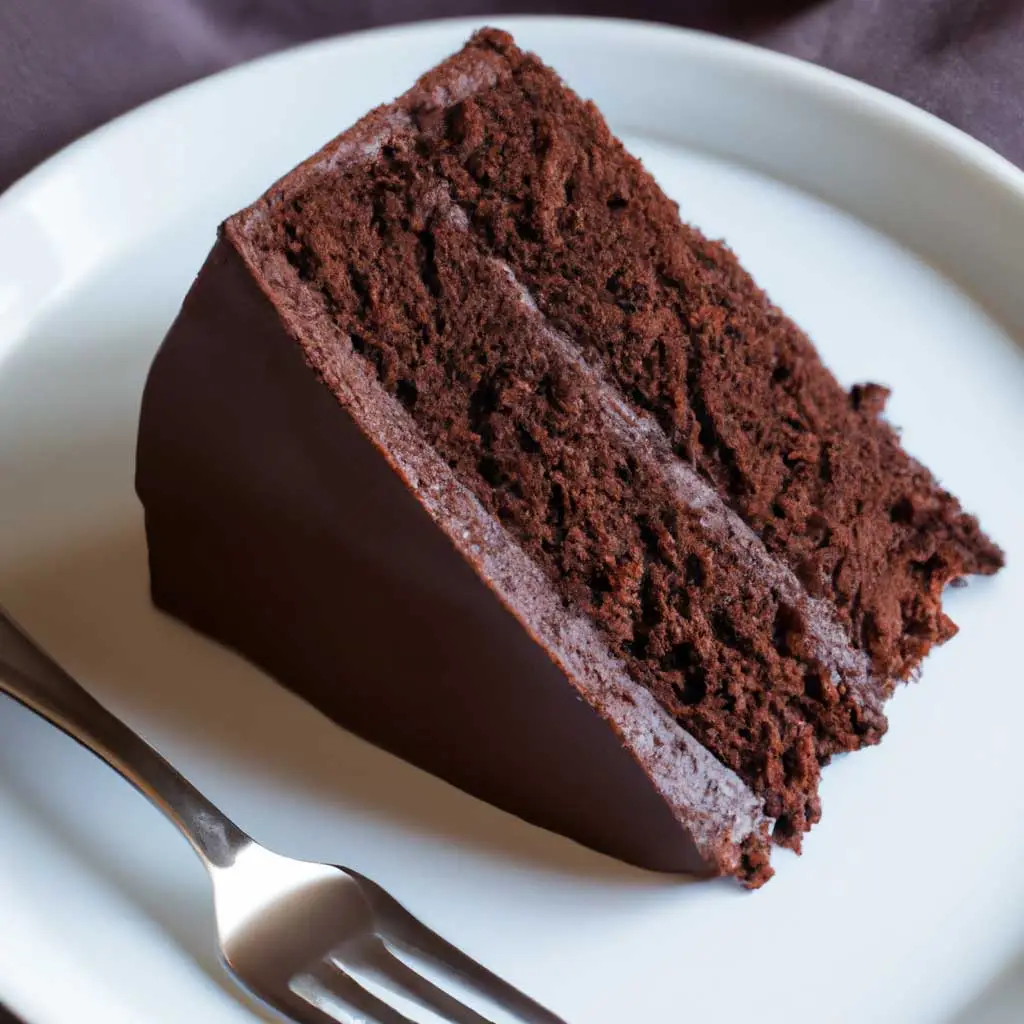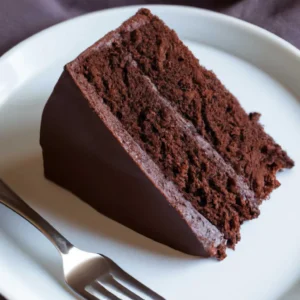
Chocolate cake is more than just a sweet treat; it’s a symbol of celebration, a comfort food, and a testament to the timeless allure of chocolate. The recipe I’m discussing today is a classic chocolate cake, loved for its rich flavour and moist texture.
This cake has a universal appeal, making it a favourite for birthdays, anniversaries, or just a comforting dessert after a meal.
The origin of chocolate cake dates back to the 18th century when it began as a variation of earlier cakes made with chocolate. Over time, it has evolved, with each era adding its unique twist.
What started with the discovery of grinding cocoa beans into a chocolate drink in the ancient Mesoamerican cultures, eventually transformed into the chocolate cake we know and love today.
The introduction of baking powder in the 19th century marked a significant evolution, giving rise to the fluffy texture that’s now synonymous with chocolate cakes.
As for the difficulty level, this chocolate cake recipe is surprisingly straightforward. It doesn’t require any fancy techniques or equipment, making it accessible for beginners. Yet, its delicious outcome will impress even the most experienced bakers.
The simplicity of the method, combined with the rich, decadent result, makes it a perfect recipe for anyone looking to start their baking journey or for those who desire a reliable and scrumptious chocolate cake.
There are countless variations of the classic chocolate cake. Some people love to experiment with different types of chocolate, varying from dark to milk or even white chocolate, each imparting its unique flavour profile to the cake.
Others introduce elements like coffee, which enhances the chocolate flavour, or add spices like cinnamon for a warming twist. For those who prefer a richer texture, adding chocolate chips or chunks creates a delightful contrast.
The frosting too offers room for creativity, ranging from a simple dusting of icing sugar to rich buttercream, creamy ganache, or even a tangy cream cheese frosting.
This particular recipe for chocolate cake strikes a perfect balance between simplicity and indulgent flavour. It uses easily accessible ingredients and follows a straightforward process, yet the result is a cake that’s moist, rich, and full of deep chocolate flavour.
The inclusion of both cocoa powder and vanilla extract in the batter creates a harmonious blend of flavours. The frosting, a combination of butter, cocoa powder, and vanilla, complements the cake beautifully, adding a layer of creamy sweetness that rounds off the chocolatey experience.
Whether you’re celebrating a special occasion or just in the mood for something sweet, this chocolate cake is an excellent choice. Its rich flavour, moist texture, and the joy it brings to those who bake and taste it, make it a truly special treat.
Now, let’s explore the ingredients and how each contributes to making this chocolate cake an irresistible dessert.
Expert Tip: To ensure your chocolate cake is extra moist, add a tablespoon of boiling water to the batter. This little trick can make a big difference in enhancing the cake’s moisture and chocolate flavour.
Plain Flour: The base of our chocolate cake, plain flour, is crucial for providing structure. It’s what gives the cake its form and ensures that it rises properly. If you don’t have plain flour, you can substitute it with self-raising flour but remember to adjust the amount of baking powder accordingly.
The flour’s role is vital in balancing the moisture from the eggs and oil, ensuring a perfect crumb that’s neither too dry nor too soggy.
Sugar: Sugar isn’t just for sweetness in our cake; it also contributes to the tender texture. Granulated sugar dissolves well and aerates the batter when beaten with eggs, which is essential for a light and fluffy texture.
For a variation, brown sugar can be used, which will give the cake a richer, more caramel-like flavour, but it might also make the cake denser.
Cocoa Powder: Cocoa powder is the key to the chocolatey taste. Unsweetened cocoa powder provides a deep, intense chocolate flavour without making the cake overly sweet.
If you prefer a milder chocolate taste, you can opt for Dutch-processed cocoa powder, which is less acidic and has a smoother flavour.
Baking Soda & Baking Powder: These leavening agents are what make the cake rise. Baking soda reacts with the acidic vinegar, creating air bubbles that help the cake to rise and become fluffy.
Baking powder, which contains both an acid and a base, adds additional leavening, especially important in recipes with less acidic ingredients.
It’s hard to find a direct substitute for these, as their chemical reactions are unique, but in a pinch, you can use extra baking powder in place of baking soda (but not the other way around).
Salt: A small amount of salt is essential in baking as it balances the sweetness and enhances the overall flavour of the cake. Without it, the cake might taste flat. If you’re using salted butter in the frosting, you might want to reduce the salt in the cake batter.
Vegetable Oil: Oil makes the cake moist. Unlike butter, oil remains liquid at room temperature, ensuring that the cake stays moist even when cool. You can substitute it with melted butter for a richer flavour, but the cake might not be as moist.
Eggs: Eggs provide structure and stability to the cake. They also help in incorporating air into the batter, making the cake light and fluffy. For a vegan option, applesauce or mashed bananas can be used, though they will slightly alter the flavour and texture.
Vinegar: Vinegar reacts with baking soda, which helps the cake rise and become fluffy. It also sharpens the chocolate flavour. You can substitute it with lemon juice or another acid, but white vinegar is preferred for its neutral flavour.
Vanilla Extract: Vanilla adds a lovely aroma and enhances the chocolate flavour. It contrasts with the bitterness of the cocoa, adding depth to the overall taste. If you don’t have vanilla extract, you can leave it out, but it does add a special touch to the cake.
Butter: In the frosting, butter provides a rich, creamy base. Unsalted butter is preferred as it allows you to control the amount of salt in your frosting. You can use salted butter, but adjust the salt in the recipe accordingly.
Icing Sugar: Icing sugar gives the frosting its smooth, spreadable consistency. It’s finely ground, which helps it blend easily with the butter, creating a creamy texture without any grittiness.
Milk: Milk adds creaminess to the frosting and helps to achieve the desired consistency. You can substitute it with cream for a richer frosting or a dairy-free milk alternative for a vegan version.
These ingredients, each with its specific role, come together to create a chocolate cake that’s not just a treat for the taste buds but also a joy to bake. The harmony of flavours and textures in this cake makes it a beloved dessert for all occasions.
Expert Tip: For a richer frosting, try using half butter and half cream cheese. This combination gives the frosting a beautifully smooth texture and a slightly tangy flavour, which pairs wonderfully with the sweetness of the chocolate cake.
Yes, you can easily adapt this recipe to be vegan. Replace the eggs with a vegan substitute like applesauce, mashed bananas, or a commercial egg replacer. For the frosting, use a vegan butter alternative and ensure your sugar is vegan-friendly. Remember, these substitutes might slightly alter the taste and texture, but you’ll still end up with a delicious vegan chocolate cake.
No worries if you don’t have a 9-inch cake pan. You can use two 8-inch pans, but the cakes will be thinner and might bake quicker, so keep an eye on them. Alternatively, you can use a 9×13-inch rectangular pan for a sheet cake, adjusting the baking time as needed. It’s all about flexibility and using what you have.
Absolutely! This chocolate cake freezes beautifully. Wrap the unfrosted cake layers in cling film and then foil to prevent freezer burn. They can be frozen for up to 3 months. Thaw them overnight in the refrigerator before frosting and serving. Freezing can actually make the cake even more moist.
Yes, using hot water can actually intensify the chocolate flavour, as it helps to bloom the cocoa powder, bringing out a deeper, more robust chocolate taste. Just make sure it’s not boiling, as you don’t want to cook any of the ingredients prematurely.
Beat the frosting for at least 5 minutes or until it becomes light and fluffy. The key is to incorporate enough air into the mixture, which gives the frosting its creamy texture. If it seems too thick, you can add a little more milk, a teaspoon at a time, until you achieve the desired consistency.
Yes, you can! Adding a teaspoon of instant coffee or replacing the water with strong brewed coffee enhances the chocolate flavour, giving the cake a richer and more complex taste profile. Coffee and chocolate are a classic pairing that works wonderfully in this recipe.
Expert Tip: When measuring flour, spoon it into the measuring cup and level it off with a knife. Avoid scooping directly with the cup, as this can compact the flour, leading to a denser cake. Proper measuring ensures a light and fluffy texture.
Here are some more recipes for you to enjoy! If you my recipes don’t forget to rate and leave a comment.
If you have any recipe suggestions, please do not hesitate to ask me. A great way to stay in contact with me is through Instagram, Facebook, Twitter and YouTube. Don’t forget to tag me @CookwithNabeela in your recipe photos!

Subscribe now to receive my latest recipes directly in your inbox. Stay up-to-date and never miss out!

I love to cook! I want to share with you my favourite, delicious family-friendly recipes. I want to inspire you to create fantastic food for your family every day.
Latest comments (4)
Delicious! Very nice recipe. Eating as i type lol x
Glad you enjoyed my Chocolate Cake recipe. If you have any questions or need more recipes, feel free to ask.
These chocolate cakes are a true indulgence! The rich, velvety layers melt in your mouth, and the decadent chocolate flavor is simply irresistible. A perfect treat for any occasion or just to satisfy your sweet cravings. Pure bliss in every bite!
Thanks so much for the kind words! I’m thrilled you enjoyed the chocolate cakes. They really are a delightful treat. Let me know if you have any questions or need more recipe ideas.